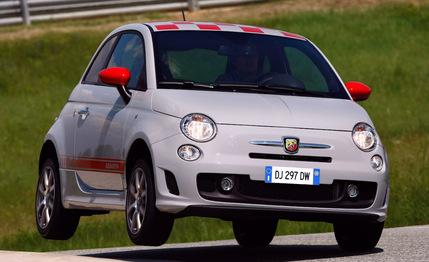 First Drive Review
First Drive Review

The impatient driver in the Mercedes-Benz E-class never had a chance. While driving the new Fiat 500 Abarth along the A13 autoroute just outside of Paris, we somehow missed the sign indicating the speed limit had jumped far above our current pace. Suddenly, the big German luxury sedan was looming in the rear window, its three-pointed star only inches from our rear bumper. The polite thing to do would be to move over and make way, but the 135-hp Abarth does not take kindly to being bossed around. A quick gearchange from the five-speed manual transmission elicited a bark from the Fiat’s little turbocharged-and-intercooled 1.4-liter four-cylinder, and the car shot down the road. In a couple seconds, the Benz became a tiny speck in the rearview mirror. Although its size is deceiving, the Fiat 500 Abarth is a full-blooded Italian sports car in a small-car package.
Reviving an Icon
When it was launched in late 2007, the standard 500 became an instant hit for Fiat, overflowing order books across Europe. For the first time, BMW’s Mini finally had a true competitor when it came to combining chic looks and fun-to-drive manners (not to mention a seemingly endless options sheet). Like the Mini, the Fiat 500 owes much of its success to a retro exterior. Inspired by the classic 500 built from 1957 to 1975, this nuova 500 could easily have sailed along on its good looks and already impressive sales record. Yet Fiat remains an Italian car company at heart for which driving passion far outweighs pie charts. The Abarth badge stretches back to the 1950s and ’60s, when company founder Karl Abarth kept busy turning grocery-getting Fiats into pint-sized track terrors. The Abarth brand laid dormant and forgotten for more than a decade before it finally was absorbed into the Fiat Group in the early 1970s.
In dusting off the name, Fiat has blended aggressive looks, sporty driving, and everyday usability. At only 140 inches long, the 500 Abarth is a joy to squirt through congested city traffic, especially with the turbocharger providing an extra 35 hp of thrust compared with the naturally aspirated 1.4-liter in the standard 500. In addition, the Abarth sits about a half-inch lower than the regular 500 and can be fitted with 17-inch wheels with provocative red brake calipers visible through the spokes. Extra vents and scoops in the hood and revised front bumper further distinguish the performance model and feed air to the engine. A high-mounted rear spoiler, beefier side skirts, and twin tailpipes on either side of the rear diffuser further the visual transformation. If that’s not enough, wild graphics adorn either side, red and yellow Abarth scorpion badges are fitted to the front fenders, and buyers can opt for an optional checkered-flag pattern for the roof.
Pint-Sized Firecracker
Fiat estimates the standard 500 with the naturally aspirated, 100-hp 1.4-liter needs about 10 seconds to reach 62 mph. The Abarth chops more than two seconds from the time at an estimated 7.9 seconds. There is almost no turbo lag off the line, but it’s the car’s midrange power that really gets the juices flowing. In truth, the car feels even faster than the figures suggest; the Abarth’s ready-to-play nature goads you to floor the gas pedal at every opportunity and feel the steering wheel wiggle as the front wheels scramble for grip. Credit for the speed and agility is partly due to the car’s scant 2282-pound curb weight.
The Abarth’s suspension—a simple setup of front struts and a rear torsion beam—delivers a firm and sporty ride, yet it won’t loosen fillings over rough roads. Depressing the sport button on the dash firms up the suspension, increases engine torque from 133 lb-ft to 152, and adds extra weight to the steering. Disengaging the sport mode will give your shoulders less of a workout when parallel parking, but our advice is to press the button once and leave it on—you’ll have a lot more fun driving, plus it will provide a good excuse to skip your next personal training session.
The 500 Abarth is based on the platform that underpins the boxy Fiat Panda city car, so finding an ideal seating position in the Abarth takes patience. The center of gravity initially feels too high, yet the leather seats hold you firmly in place when chucking the car into corners. Like the Mini Cooper, space in the rear of the 500 is cramped, and there is the occasional cheap-looking plastic component.
For the moment, the 500 is not for sale in the U.S., but this could change now that Chrysler and Fiat are in the process of forming an alliance. We hope so, because the 500 Abarth oozes more attitude than the entire cast of The Sopranos . It can even seat four—in a pinch—and averages more than 40 mpg in the combined European cycle. And did we mention there’s an even hotter 160-hp SS model? Pricing in Europe is a bit steep, with the Abarth starting at about $7000 more than the regular 500’s $16,000 entry fee. But as automotive stimulus packages go, the 500 Abarth is worth every cent.